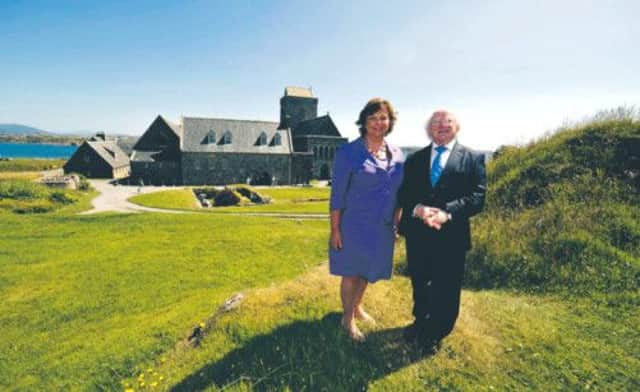Iona celebrates anniversary of St Columba’s arrival


And yesterday leading politicians from Scotland and Ireland met to celebrate the 1,450th anniversary of the arrival of the saint who forged the reputation of the tiny community of Iona.
Culture secretary Fiona Hyslop and the president of Ireland, Michael D Higgins, attended a special service held at Iona Abbey, built by St Columba in the sixth century following his voyage from Ireland to the Inner Hebrides.
Advertisement
Hide AdThe day-long event was aimed at celebrating Ireland and Scotland’s shared history and language at the personal invitation of Peadar O’Riada, leader of Irish choir, Cór Cúil Aodhathe, and the Iona Community.
Higgins, who was accompanied by his actress wife Sabina, paid tribute to the link in a speech entitled “Of Migrants and Migration”. He said: “Sabina and I are happy to be on this sacred island – a place of learning and of cultural richness, which has always retained its own very special local identity.
“Far beyond anything I have to say here today, I am most interested in hearing the words of others – as to what it is like, what has flowed from the experience of living in this extraordinary place of inter-faith living. What they may wish to reveal as to the difference Iona, past or present, has made to your beliefs and thoughts.”
Hyslop said the occasion was a fitting way to celebrate Scotland’s links with its Irish neighbours.
She said: “St Columba’s journey to Iona is just one of the many events which have created our strong bond with Ireland and it’s important that we recognise and celebrate the continuing significance of this remarkable man and the community he founded.
“The Scottish Government continues to recognise and value the substantial and enduring work of the Iona Community and the role it plays as part of Scotland’s diverse faith and belief communities.”
Advertisement
Hide AdHiggins has not been the first Irish leader to pay tribute to a moment in history that forged the strong bonds between Scotland and Ireland. Mary Robinson visited Iona in 1997 for the 1,400th anniversary of the death of St Columba.
The monastery, founded by Columba, from where yesterday’s speech was delivered, played a significant role in spreading Christianity throughout Scotland.
Advertisement
Hide AdIt became a community of worship, study, service and hospitality at the centre of a network of sea routes that would link Ireland, Scotland and places as far afield as North Africa and the Near- East.
New monasteries would be founded in Ireland and at Lindisfarne in Northumbria on the model laid down in Iona by Columba.
In Pictish Scotland, Columba’s monks would start spreading the word of Christianity in the seventh century.
Columba’s role may have been forgotten completely following his death in 597 if not for the ninth Abbot of Iona and his book, the Vita Colum Cille (Life of Columba).
The tome guaranteed the saint’s reputation would eclipse that of other Scottish saints, with Iona’s fame spreading across Christendom and turning the small Scottish island into a magnet for pilgrims. Kings increasingly wanted to be buried close to Columba’s remains and a network of Celtic high crosses and processional routes were developed around the saint’s shrine.
The Book of Kells – a religious work in Latin regarded as a masterpiece of Dark Age European art – was believed to have been produced on Iona at the zenith of the monastery’s influence.
Advertisement
Hide AdThe active role of the island in advancing the Christian movement would only end in 794 with the invasion of the Vikings. Within 50 years, the island would be stripped of Columba’s relics, with the treasures divided between Scotland and Ireland.
The Book of Kells, now regarded as Ireland’s finest national treasure, is on permanent display at the Trinity College Library in Dublin.
Advertisement
Hide AdBut Historic Scotland is also guaranteeing the island’s legacy is not forgotten. A new visitor centre is opening this summer and funds have also been spent on conserving the collection of carved stones and crosses at the abbey site and researching the location’s history and archaeology.